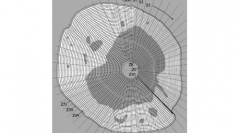

 Comptes Rendus Palevol
5 (3-4) - Pages 603-618
Comptes Rendus Palevol
5 (3-4) - Pages 603-618The compactness profile of femoral cross-sections and body size of 46 species of lissamphibians was studied to assess the relationship between lifestyle (aquatic, amphibious or terrestrial) and bone compactness. Two tests that incorporate phylogenetic information (permutational multiple linear regression incorporating phylogenetic distances and concentrated changes tests) show that the return to an aquatic lifestyle is associated with an increase in the compactness of the femur and an increase in body size. However, amphibious taxa cannot be distinguished from terrestrial ones on the only basis of size or compactness. Mathematical equations obtained from our data using logistic regression with phylogenetic weighting are used to infer the lifestyle of four early stegocephalians from the Permian and the Triassic. The results are generally congruent with prevailing palaeontological interpretations, which suggests that this method could be applied to infer the lifestyle of early taxa whose lifestyle is poorly understood.
Bone microstructure, Compactness, Lissamphibians, Palaeoecology, Tetrapods